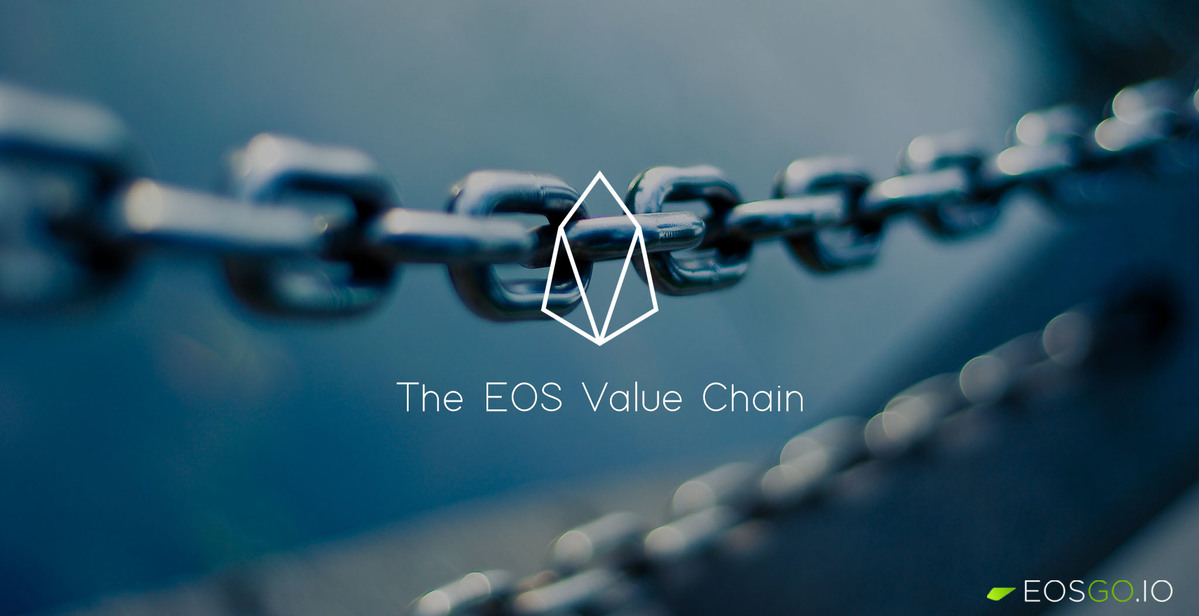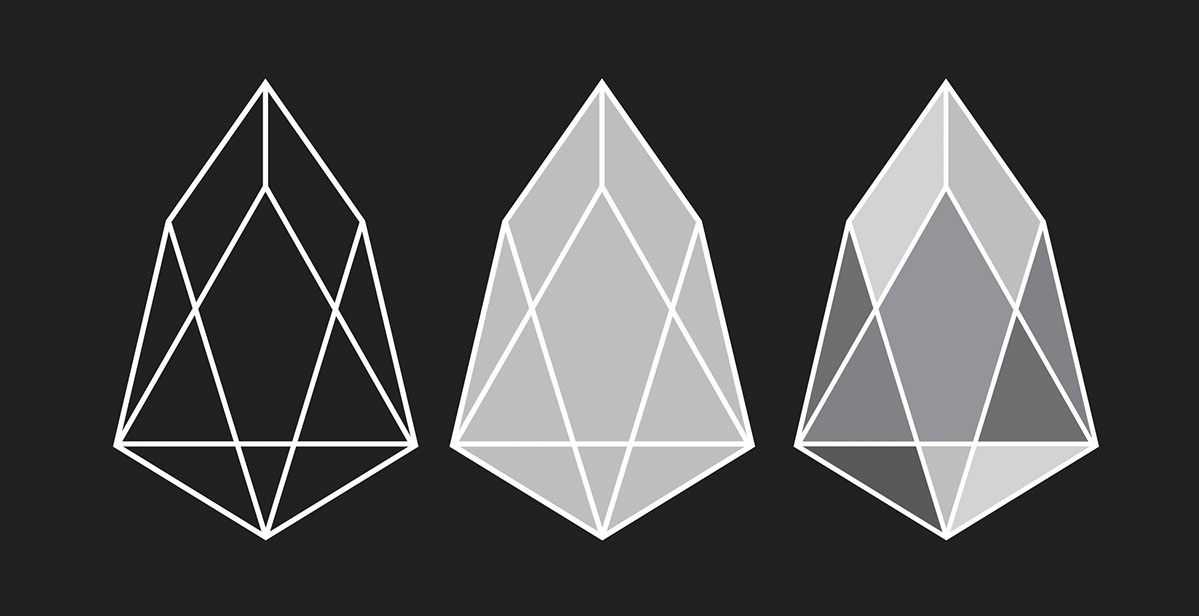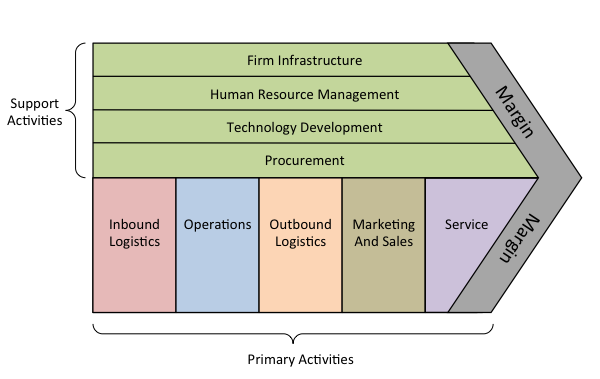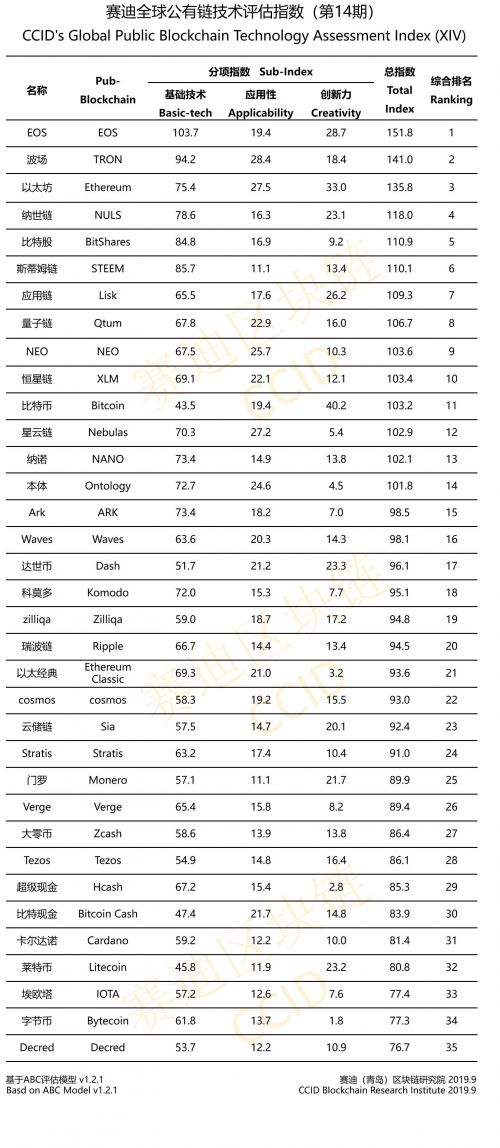The EOS value chain
Article credited to cryptomandate and provided by EOS GO

These past few weeks I’ve had to take a step back and re-evaluate on where EOS is today compared to where it was when it first launched its mainnet, in June 2018. People will be quick to point out that the price of EOS back then was much higher than it is today. While some will counter that we’re currently in a bear market, another may point out that Bitcoin is up nearly 50% in that same time span. A familiar and all too frequent back and forth between the faithful EOS believers and the fearful, uncertain, doubtful members of the community. A debate that can drive one insane if they’re constantly involved in it.
As someone who’s constantly trying to educate people about EOS and its significance to the world, I often find myself deep in such debates all over the internet. Each day I log online I’m fully expecting to battle trolls and FUDsters spreading misinformation about EOS on every channel they can find. A game they enjoy very much but one that’s slowly driving me nuts; explaining the same things over and over again to audiences of short attention spans. Governance issues, congested network, stagnant price, new account costs et cetera. As a full-time believer who’s gone through the ups and downs I myself sometimes question whether progress is being made.
To truly figure out whether progress is being made I had to stop and analyze what actually creates value. Reflect on everything that has happened since June 18 and try to mirror that forward. Price is and will always be a reactive market indicator not necessarily a value indicator, at least not in the short term. It was time to be critical of EOS once again and ask the tough questions. What creates or makes EOS a valuable asset?
To answer that question, I analyzed one of the most important factors which determine the solidity of any single organization, and that is its value chain.
Although a blockchain operates differently to a traditional business, its value chain is similar to traditional businesses as its aim is also to create value. EOS in particular is unique in the way it is setup to a point where it’s organization’s structure could be defined as being a decentralized company. It’s such a solid structure that each of its segments provide support to benefit the entire blockchain. The chestahedron being the perfect illustration for such a structure.

Value Chain
A value chain is a set of activities that a company in a specific industry performs in order to deliver a valuable product/service for the market. A model that describes the full range of activities employed to deliver that product/service. In a traditional business environment these include inbound logistics, operations, outbound logistics, marketing and sales, service, firm infrastructure, human resource management, technology development, procurement.
These activities are then further split into primary activities and support activities. Primary activities are the five main activities which are vital in the production and selling of the product. Support activities exist to provide support to the primary activities by means of the best possible functions or support systems.
Let’s have a look at the presence of each of these activities on EOS and how they affect the blockchain.

Primary activities
Inbound logistics
In a traditional sense inbound logistics are inputs such as raw materials that are purchased, received, stored. This means contact with external companies such as suppliers is part of the process in acquiring some of these raw materials.
On EOS these are the resources such as CPU, NET and RAM which are either purchased, staked or stored. You can purchase these resource from different suppliers or service providers. These resources are used to power all your on-chain transactions. Whether you’re trying to develop a product (dApp) or simply just to play your favorite EOS game, you’ll need to have these resource as they provide you with access. Luckily these resources can be cheaply rented on a monthly basis for serious developers or have blockchain users.
Other forms of resources are dApp building tools and Software Development Kits. Since EOS is open-source, most of these types of resources can be obtained for free provided by independent entities of the EOS ecosystem. Block.one is a huge contributor of essential resources and is always releasing new and advanced tools for developers to make use of.
Operations
Operations is the conversion of resources into a finished product. Take a developer for instance, they use their EOS resources to build dApps – a finished product. Many parts are involved in building a dApp similar to building a car and it’s a process involving assembly, testing, maintenance and packaging a dApp so that it is appealing to the user.
Outbound logistics
This has to do with how the product (dApp) is delivered to the customer (user). Since EOS is not a traditional brick and mortar organization, delivery of its products are somewhat instant due to the nature of the internet. Once a dApp is deployed on the blockchain it is already in the hands of the customer. They simply just have to login and start using it, provided they have an EOS account.
Service
How is the product (dApp) giving value to the customer? What experiences can be added in ensuring that the customer is happy with their product. What use or need does the product fulfill? The blockchain ecosystem is very quick if a customer tries out your product and doesn’t like it they just move on to the next thing either on EOS or a competing blockchain.
Finished products need to be easy to use and understand meaning a sound user-interface is vital to a dApps success. I find that many developers don’t put as much emphasis on the User Interaction and Experience (UIX) part of their dApp as they do on coding. The coding is not what the user sees and no matter how smooth the dApp runs if it’s not easy to understand and appealing to the eye, then people won’t use it.
Marketing and Sales
Just because you have a finished and working product doesn’t mean that people will go out of their way to use it. Which is why companies need to advertise their products and services in a way that clearly distinguishes the value their products have over a competitor’s. This is something that’s lacking from many blockchains. Projects like Ethereum and Litecoin are valued higher because they had a first mover advantage, meaning they were the first to enter their respective markets.
Many developers who wanted to work with blockchain technology adopted Ethereum as their workplace greatly because it was the only dApp company in town. Not taking away anything from Ethereum’s innovative tech at the time. The landscape has changed since then as EOS and TRON have become serious contenders.
EOS markets itself as a cheaper, faster and more scalable blockchain than any of its competitors. This has brought in many developers to build their dApps on this blockchain some of which came from Ethereum. According to data from State of the Dapps, Ethereum still holds a great lead over its competitors with eight times as many dApps than its closest rival - EOS.
One great advantage EOS has in this segment of the value chain is that it is backed by Block.one. Having raised $4 Billion in the sale of EOS tokens Block.one has the largest marketing budget in the entire blockchain space. Hundreds of millions of dollars are to be spent in the advertising and promotion of its products and services, ergo EOS.
Support activities
Procurement
Procurement is the purchasing function in the value chain. Purchasing of resources, software development kits (SDKs) or even dApps is important in providing support to all the value chain activities. Native blockchains can also be included here as they provide additional value to the main EOS blockchain.
Each token listed under the EOS blockchain form part of procurement as they can be traded (purchased) with EOS. Each of this tokens have different qualities and use cases contributing in attracting a wide variety of buyers into the ecosystem. Procurement needs to be strategic in order to deliver maximum impact and value across the value chain.
Technology development
It’s almost impossible to operate a business without implementing technology. Making technology development one of the more vital activities in a value chain. This is a process most organizations refer to as Research and Development (R&D). When done effectively technology development can reduce production time and improve quality. It can also support the service activities through innovations like telecommunication or social media to directly connect with your customer or target audience.
Smart-contracts are a great example of technology development because they automate processes, eliminate the middle man and lower operating costs. All while providing support to many of the other value chain activities such as inbound logistics, operations etc.
The latest issue of CCID’s Global Public Blockchain Technology Assessment Index has EOS as the leading blockchain overall, but relevant to this segment it leads all other blockchain in terms of basic technology.

At the pace EOS is developing I don’t see any other blockchains catching up instead I expect the technology gap to further extend in the coming years.
Human Resource Management
HRM is the recruiting, hiring, firing, training, development and compensation of all kinds of personnel. On the blockchain these people are the block producers, dApp developers and SDK builders. Since EOS is decentralized and open source many of the personnel work independently and some work without compensation but for the creation of value for all those who possess EOS tokens.
Independent organizations still need to recruit top talent if they want to build themselves reputable brands on the EOS ecosystem thus further strengthening the value chain and quality services. Having a decentralized and open source network has allowed EOS to attract a vast range of skilled individuals to contribute to the blockchain.
Block.one, LiquidApps, and Everipedia are some of the independent entities that are recruiting skilled personnel to help strengthen their organizations so to provide quality services on the EOS blockchain.
Firm infrastructure
It includes the activities such as strategic management, planning, finance, legal, government affairs and quality management. This infrastructure supports the entire value chain and not just single activities. It is obvious to point out that this translates to the core EOS blockchain, how it’s governed and operated. Yet another great benefit that EOS has over its competitors.
EOS (Dan Larimer) pioneered the delegated proof of stake (DPoS) consensus as an alternative to the other forms of governance. With DPoS consensus can be reached much quicker which is a vital component for a new innovation to quickly grow. This also means strategic management, planning, finance, government/governance affairs and quality management can be done a whole lot faster. This is mainly due to the fact that the power to do so is elected to a number of highly capable entities or block producers.
This fast paced growth is evidenced by the continuing upgrades to the core blockchain and the innovations implemented by its stakeholders. Since launch EOS has far outpaced any other blockchain in terms of development and innovation. All of the independent entities indirectly support each other by supporting the blockchain. For instance, the decision to make resources available for rent has lowered costs for every developer on the blockchain, making developing on EOS cheaper than on other blockchains.
Final thoughts
I believe that the biggest reason Block.one hasn’t begun advertising to the masses is because the blockchain’s ecosystem is not yet complete. First of all, there’s the underlying infrastructure which needs to be upgraded and strengthened further to be able to support mass adoption. Secondly, EOS’ governance has minor issues its yet to overcome along with user’s confidence in it. Lastly and certainly not limited to, the ecosystem still needs more dApps and services to ensure that people don’t switch blockchains because of a lack thereof.
Everyone must have use of the blockchain to justify mass marketing. Voice will only be the first of many mass applications on the EOS blockchain. Businesses that create the most value to its customers are highly valued by the market. Take Facebook, Google or Amazon for instance. Users can barely imagine their lives without any of these companies as they’re provided with such easy access to everything they care about.
Most of the negativity on EOS is brought by individuals who are incentivized to do so because it threatens their investments in other blockchains. This negativity I take as a compliment and a sign that we’re going in the right direction. Then there’s the negativity that comes from newbies who’ve just recently been involved in blockchain. They never experienced the bear market before that record breaking 2017 bull run. Simply put, they lack the understanding and maturity to bear through the tough market conditions (no pun intended).
Last time I checked EOS is still about bringing solutions to a corrupted system and building a blockchain like none other. Change isn’t easy and isn’t accomplished overnight. As I alluded to earlier there’s still a lot of work to be done in building and bringing a wide variety of services to the blockchain. In any organization sales play the biggest role in the success of a business. EOS outmatches competitors in all of the segments of its value chain, but for marketing and sales which Ethereum has a clear first mover advantage on. It won’t be too long though before adoption (sales) catches up with quality.
Conclusion
I’ve hopefully laid out the vast value EOS has, especially over competitors. Most blockchains are mostly just patches of preceding ones with little vision or philosophical presence to justify their long term success. EOS on the other hand is a well-oiled machine that’s being built from the ground up into a massive conglomerate.
EOS is valuable not only as a blockchain but as an organization. It is scaling quickly. It’s capable of making quick effective decisions regardless of its diversity and global scale. Users are afforded free transactions on the blockchain. It is by far the cheapest blockchain for developers to build and test their dApps. Despite all these amazing features it isn’t slowing down on innovating and upgrading current systems.
What does the future hold for EOS? That’s a question that means so many things to different people. For me, EOS is the future.
I hope that I was able to write this article in a way that’s easy to grasp. I took a business concept and applied to the blockchain to better pin point its value areas. The EOS ecosystem is still being built out. It may take five years for it to be completed but once it is complete, they’ll be nothing holding it back. Prices rise and fall but those that make it to the other side are those who’ve stood the test of time.
Thank you for reading!
Have a great one.
Disclaimer: The views expressed by the author above do not necessarily represent the views of EOS GO. EOS GO is a community where EOS GO Blog being a platform for authors to express their diverse ideas and perspectives. Any referral links present were placed directly by the author, from which EOS Go does not derive any benefits. To learn more about EOS GO and EOS, please join us on our social medias.
EOS GO is funded by EOS ASIA and powered by YOU. Join the community and begin contributing to the movement by adding eos go to your name and joining the EOS GO telegram group.